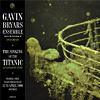 The Sinking of the Titanic is a piece of music that is a lot more than notes arranged in a certain order. It is the perfect marriage of conceptual art, music and raw emotion. In this reissue of a 1990 performance (originally on Les Disques du Crépuscule), the conceptual side of the piece come to the fore as Gavin Bryars and his ensemble perform in a water tower and push the piece for the first time well beyond the constraints of previous performances.
The Sinking of the Titanic is a piece of music that is a lot more than notes arranged in a certain order. It is the perfect marriage of conceptual art, music and raw emotion. In this reissue of a 1990 performance (originally on Les Disques du Crépuscule), the conceptual side of the piece come to the fore as Gavin Bryars and his ensemble perform in a water tower and push the piece for the first time well beyond the constraints of previous performances. The reissue of this particular recording comes at a particularly poignant time both in light of the history of the Titanic, recent air disasters and for personal reasons. Last month, the only remaining survivor of the Titanic disaster passed away aged 97. Although Millvina Dean was only a baby at the time, it is an important milestone in the history of the Titanic as its last human link has now left us and Bryars work now becomes musical archaeology. Equally, it is hard not to think of lives lost in the recent air disasters involving Air France off Brazil and Yemenia Airways off the Comoros Islands which have both resulted in so much loss of life. In particular, the Yemenia Airways disaster has a touch of that Titanic myth with its sole survivor being rescued despite the totality of the destruction.
On a more personal note, I lost my grandmother earlier this year after a long battle with illness. We used to watch movies together and one of the last films we watched together was her favourite, A Night to Remember. In the film, when the Titanic goes down the band play the hymn “Nearer, My God, to Thee.” At her funeral, we requested “Nearer, My God, to Thee” to be sung and in the weeks after, I found my own solace in the The Sinking of the Titanic. Of course, the music Bryars based his piece on was not “Nearer, My God, to Thee” but on the hymn “Autumn” as this is the most likely swan song according to the accounts from the last survivors who abandoned ship. In the sleeve notes (as interesting as the music), Bryars discusses how different hymns became tied up in the myth surrounding the Titanic but equally how important each of these myths are to the nature of his piece.
Out of the four recorded versions now available of The Sinking of the Titanic, I will admit that this one is the least satisfying. The performance starts too hastily for my preferences (the first few bars sounding a little forced) and its length (an hour) is not really justified when compared to the superior short version and the better developed long versions that were recorded afterwards. However, aside from these frankly minor reservations there is little here to fault. Bryars utilisation of violas instead of the usual violins gives the music has a softer feeling. The layout of the piece and it is fascinating to hear the introduction of new elements like marimba, bass clarinet and the bell which are used so effectively in later recordings.
The edges are further blurred by the resonance of the water tower in which it was performed. Out of the three storeys of the tower, the ensemble played on the lowest storey (after having the water drained out) while the audience were placed on the middle floor. In order to further link the music to idea of an orchestra playing as they submerge, all the music was channelled through the empty top storey before reaching the audience; in essence the music was filtered by the water tower. In the sleeve notes, Bryars relates an incident of art imitating life as he reveals that shortly into the performance, the drained water started to leak back in and fill up the water tower as they played. Finding himself in the same position as the orchestra he is so fascinated with, his ensemble risked their own safety in order to finish the piece (although in more danger of electrocution rather than drowning).
Overall, there is so much tied up in Bryars’ The Sinking of the Titanic that I find it hard to be in any way objective about it. Even without the knowledge of the thinking behind the piece, the music is so startling in its beauty and its sadness that it is essential listening on that level alone. Combined with the conceptual side of things (and for me, its emotional baggage), it is a devastating work of such magnitude that I cannot begin to convey how vital it is. This reissue may not be The Sinking of the Titanic in its most perfect state but it shows how the piece evolved from its 1975 recorded debut on Obscure Records to the masterful and definitive 1994 recording on Point Records; further reinforcing Bryars insistence that this be a continually evolving composition.
samples:

